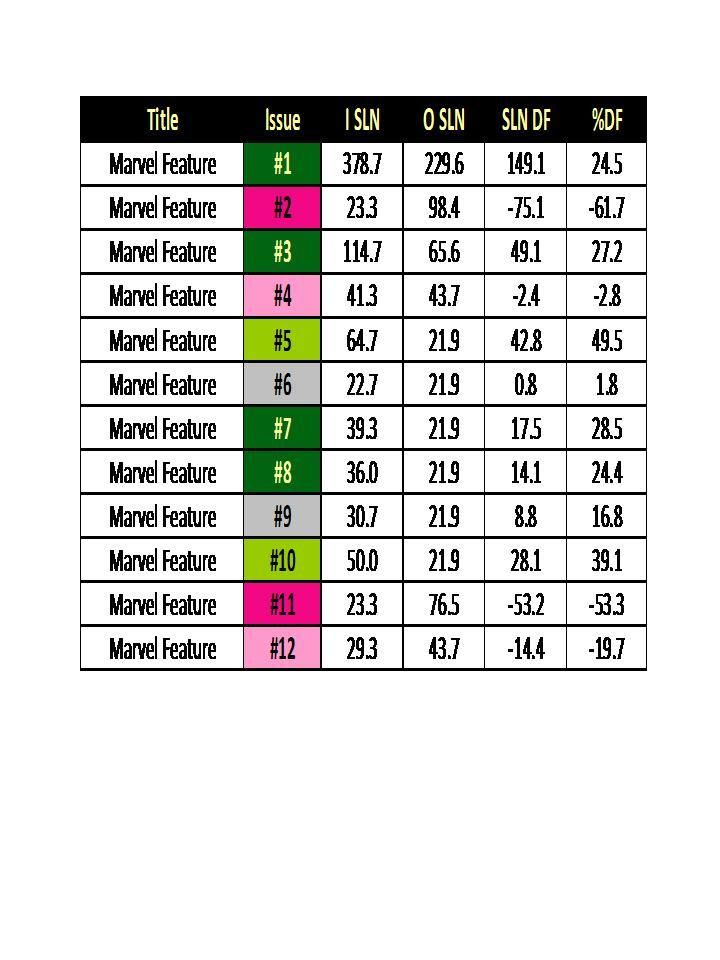Investment Potential and Analysis of Marvel Feature Issues 1 to 12
Investment Potential and Analysis of Marvel Feature Issues 1 to 12
The first table presents the Bias Scores for all the issues. Bias scores show which issues are being bought by the Insiders (Pros) vs. the Outsiders (Fans Less Serious). The concept of my approach is to focus on the issues being bought BULLISHLY by the investors.
We developed an analysis of data to quantify this Bias (B Score). We mark the issues with the highest Bias with Lime Green followed by a Dark Green staining for issues with a lesser but definite Bias.
We see the main issue is issue 1 the first appearance of the Defenders but two story Arcs preceded the Defenders. They were the first ARC in Doctor Strange #183 (Nov. 1969), Sub-Mariner #22 (Feb. 1970), The Incredible Hulk #126 (April 1970) and the second Arc found in Sub-mariner #34 and 35. These ARCs are thought to be the beginnings for the Defenders!
Issue 1 has a Good B Score of 249, issue 3 ( the last Defenders story here) has a score of 59 and Issue 5 has a score of 28. They rest of the issues are overbought by fans vs Insiders. Note the overbuying of Issue 2. We have seen that in other Titles. See Tales of Suspense 40 as an example.
Table 1. B Score Bias of Marvel Feature Issues 1 to 12

Table 2 data deals with another data stream on comic-book issues. This run’s issues are looked at 3 grades 9.4, 8 and 6. The changes in bias between the different grades are calculated and the SLN numbers were born. The SLN numbers look into each “world” of the I vs. O bias data. This data has shown historically to be the most liberal and establishes the investment potential across the grades of 9.4, 8 and 6.
Very quickly, the green stained are positive issues and red stained issues are a negative and invite a non-focus in only investments We then compare those SLN numbers and generate a difference number we call the DF. Finally add the I and O SLN numbers together (total) and determine the %DF number for each issue. Green staining is good (Higher Bias) and Grey and Red are issues that are not good for an investment focus. This data stream is more liberal in the rigor and you get the best case for an issue.
Issue 5 seems to stand out and it is an ANTMAN issue, that took over from issue 4 from the Defenders.
Issue 10 has the Avengers and is highlighted as well here as well.
Table 2. SLN, DF and %DF of Marvel Feature Issues 1 to 12

The deepest level of analysis we developed is the ADF number (average difference between the I/O worlds) of each issue at each grade. I denote a high I Bias with the orange $. Lime green stained issues are rated I Biased in all grades or at least 9.4 and 8. Dark green stained issues are only biased at the 9.4 grade while the other grades are overbought relative to the professional investor’s desires. Table 3 is the stricter data stream and highlights both the issue and grade.
We calculate the average difference (ADF) in Issue Bias between the Insider and Outsiders groups. Lime Green are issues that are I Biased at least 9.4 and 8 grades (High Bias). (Orange $). The dark green issues are support with a Bias in 9.4 grade only. The other issues are to be avoided.
We see issue 10 is the best issue for investment at 9.4 and 8. Also next are Issues 1, 3 and 5 at 9.4 grade only. Issue 1 has some evidence for a grade 6 investment. Grade 8 has been overbought by the fans vs Insiders!. Fans can afford the 9.4 so they jump onto the grade 8 as their 9.4 grail!. They ignore then grade 6.
Table 3. ADFs at Grades 9.4, 8 and 6 of Marvel Feature Issues 1 to 10

Table 4 is the Score Card information for each issue at the 3 data streams. This allows a top down view across the data streams. We denote the issues supported in all three data streams with a Lime Green staining. Dark Green has only 2 data streams support and yellow issues are supported in one data stream only.
The data here look top down and we see issue 1, 3, 5 and 10 are the main one to work on.
Table 4. Score Card of Marvel Feature Issues 1 to 10

Table 5 is the last bit of data, the Scaled Desire Ranking. I have grouped 1356 issues of comics that I have covered and developed scaled desire rankings. The percentile that an issue occupies gets wonderful insight into true value between titles. So we position our title and its key issues in context. A score of 99 means that comic issue is desired at the highest level while 1 percentile is the lowest desired issue.
The desire scale rankings are surprising in that we have issue 1 is in the 88.6 percentile level. That is very very good for a bronze age issue! Issues 3 and 5 are at the 70th percentile level.
Table 5. Scaled Desire Rankings of Marvel Feature Issues 1 to 10


Comments
Post a Comment